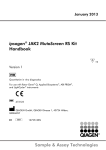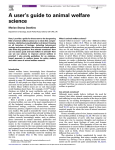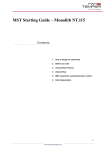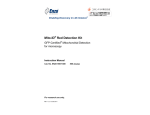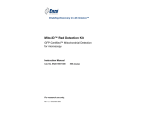Download Get - Wiley Online Library
Transcript
Proteomics 2011, 11, 1153–1159 1153 DOI 10.1002/pmic.201000548 TECHNICAL BRIEF Mass spectrometry-based immuno-precipitation proteomics – The user’s guide Sara ten Have, Se´verine Boulon, Yasmeen Ahmad and Angus I. Lamond Wellcome Trust Centre for Gene Regulation and Expression, College of Life Sciences, University of Dundee, Dundee, Scotland, UK Immuno-precipitation (IP) experiments using MS provide a sensitive and accurate way of characterising protein complexes and their response to regulatory mechanisms. Differences in stoichiometry can be determined as well as the reliable identification of specific binding partners. The quality control of IP and protein interaction studies has its basis in the biology that is being observed. Is that unusual protein identification a genuine novelty, or an experimental irregularity? Antibodies and the solid matrices used in these techniques isolate not only the target protein and its specific interaction partners but also many non-specific ‘contaminants’ requiring a structured analysis strategy. These methodological developments and the speed and accuracy of MS machines, which has been increasing consistently in the last 5 years, have expanded the number of proteins identified and complexity of analysis. The European Science Foundation’s Frontiers in Functional Genomics programme ‘Quality Control in Proteomics’ Workshop provided a forum for disseminating knowledge and experience on this subject. Our aim in this technical brief is to outline clearly, for the scientists wanting to carry out this kind of experiment, and recommend what, in our experience, are the best potential ways to design an IP experiment, to help identify possible pitfalls, discuss important controls and outline how to manage and analyse the large amount of data generated. Detailed experimental methodologies have been referenced but not described in the form of protocols. Received: August 31, 2010 Revised: December 7, 2010 Accepted: December 10, 2010 Keywords: Cell biology / Cumulative analysis / Immuno-precipitation / Protein frequency / Quality control / SILAC The ability to purify and specifically produce antibodies in the late 1960s and 1970s [1–3] facilitated the development of targeted protein analysis. Antibodies facilitated protein Western blotting [4]. Protein interaction studies began analysing one protein at a time. Today the use of MS [5, 6] in combination with immuno-precipitation (IP) [7] allows hundreds of proteins to be identified in a single experiment. However, usually the majority of proteins identified in IP experiments are non-specific binders [6]. The solid Correspondence: Dr. Sara ten Have, Wellcome Trust Centre for Gene Regulation and Expression, College of Life Sciences, University of Dundee, Dow Street, Dundee DD1 5EH, Scotland, UK E-mail: [email protected] Fax: 144-1382-348072 Abbreviations: IP, immuno-precipitation; PFL, Protein Frequency Library & 2011 WILEY-VCH Verlag GmbH & Co. KGaA, Weinheim matrices, e.g. agarose, sepharose and magnetic beads, which are essential to the IP protocol, are the main contributors to non-specific binding, with a smaller contribution from protein binding to antibodies and tags (Fig. 1A). SILAC [8] has ushered in a more accurate, multiplexed method of condition-dependent comparison, which has in turn enabled the relative quantitation of putative protein interactors and contaminants in IP experiments [5–6]. SILAC labelling utilises artificially increased levels (98% in specific amino acids – generally arginine and lysine) of stable isotopes (i.e. carbon 13, nitrogen 15 and deuterium). Cells of choice can be grown in normal ‘light’ cell culture media (arginine 0, lysine 0), or combinations of arginine (13C6, ‘R6’ or 13C6, 15N4, ‘R10’) and lysine (4, 4, 5, 5-D4, ‘K4’, 13C6, ‘K6’ or 13C6, 15N2, ‘K8’) supplemented media. Aside from the convenience of combining the bead control (arginine 0, lysine 0), with the IP of interest (arginine 6, lysine 4), and if required a third condition (e.g. comparing www.proteomics-journal.com 1154 S. ten Have et al. Proteomics 2011, 11, 1153–1159 Figure 1. (A) The above diagram characterises the relative changes (percentage of protein identified in IP results (right) and total percentage of protein as a fraction of cell extract (left)) in terms of the abundance of the proteins identified in response to different experimental procedures. Whether comparing intensities directly in a label-free experiment, or utilising a SILAC approach to quantify proteins, these changes should be taken into consideration. It also indicates the importance of having a bead control (non-specific proteins which bind to beads) characterised for every experiment – because the non-specific proteins identified in bead controls vary for different cell lines, antibodies, beads, etc. (B) The immuno-precipitation workflow. Protein–protein interactions analysis utilising IP techniques can be approached in many different ways, using complex samples such as tissue biopsies, or single cell-type samples, and with labelled or label-free scenarios, illustrated by the flow chart. & 2011 WILEY-VCH Verlag GmbH & Co. KGaA, Weinheim www.proteomics-journal.com Proteomics 2011, 11, 1153–1159 interaction partners of wild type and mutant proteins, arginine 10, lysine 8), this protocol can reduce or eliminate both machine variation and human error. The IP preparations from each sample are mixed in equal ratios (1:1:1); therefore, proteins that do not change between conditions (experimental contaminants) will have an expected log 2 ratio of 0 (in practice 0.32olog 2 ratioo0.26, which is not symmetrical, but characterised experimentally). Proteins that have been enriched relative to the control (putative specific interaction partners) will have increased log 2 ratios (i.e. usually 40.26) and environmental contaminants generally have a low log 2 ratio (typically o 0.32, see Fig. 3). Protocols and information regarding these SILAC methodologies are available at www.LamondLab.com. Experimental design is dependent on the question being asked (Fig. 1B), and therefore dictates control(s) required to accurately distinguish changes due to biologically relevant effects. An initial, exploratory IP experiment is usually 1155 recommended. Tricks for the optimisation of IP experimental design are given in Table 1 to help increase the efficiency of the protein recovery and to reduce and/or identify putative contaminants. One important step to improve the accuracy of conclusions drawn from IP data is to characterise the range of nonspecific binding proteins. The non-specific proteins identified in IP experiments vary considerably and depend on parameters such as cellular fraction utilised, cell type, bead type, etc. This was described previously in ‘Identifying specific protein interaction partners using quantitative MS and bead proteomes’ [6], and has since been developed into a more general approach in the form of the Protein Frequency Library (PFL) [5] and described below (see Data management section). To look at and assess the statistics of the entire population of identified proteins is required for labelled and unlabelled scenarios alike (Figs. 2 and 3). The way to go about Figure 2. The graph depicts the normalised distribution of average (log) protein intensities detected in all protein identifications, showing the normalised distribution of the population. The three graphs derived from the main graph describe the frequency of occurrence of the proteins in each protein intensity region. It is interesting to note that the number of proteins in the highest intensity range is 100-fold less than the numbers seen in the low and mid-intensity ranges. This indicates that the very high intensity proteins are only a small percentage of the proteins seen. Secondly, the graphs show a positive correlation between protein intensity and frequency of occurrence, which suggests that high-intensity proteins have a higher likelihood of being contaminants. Therefore, using a tool such as the Protein Frequency Library to tease apart significance of these protein identifications is helpful. The data shown above consists of 21 682 independent protein identifications, from 140 IP experiments performed in two different laboratories. These IP experiments included GFPtagged protein pull downs, endogenous protein pull downs and included the use of agarose, sepharose and dynabeads. The peak of 600 proteins at 0 is due to the ability of MaxQuant to identify proteins/peptides from the MS/MS spectra, with insufficient information from the MS spectra to determine intensities. & 2011 WILEY-VCH Verlag GmbH & Co. KGaA, Weinheim www.proteomics-journal.com 1156 S. ten Have et al. this is described below in two sections – firstly for (a) labelfree IPs and secondly for (b) labelled IP experiments: (a) Unlabelled IP analysis (i) Population statistics – This requires the frequency of protein intensities to be measured (note raw ion intensities should not be compared directly, but the median of the intensities from all peptides identified for a protein, with any skewing due to experimental and/or machine error/inaccuracy factored into these data). Examine the range of these values (using the log of the intensity values as this is more practical to deal with) and logically divide these evenly into bins. Then group proteins by their corresponding bins. This gives the frequency of the average intensity values of the identified proteins (Fig. 2). This is useful for two main reasons. It provides a measure of the quality of the data (i.e. it should show a normal or bell-shaped curve, if not the data are biased or skewed) and highlights which proteins Proteomics 2011, 11, 1153–1159 are significantly enriched – and therefore putative, specific interactor(s) for the bait protein. (ii) Determining significance – In Fig. 2, the graph was generated from 140 separate IP experiments – consisting of 21 682 protein identifications, using human cell lines, many different antibodies, bead types and GFP tagged proteins from multiple researchers in two different laboratories, using Thermo Orbitrap XL and Velos mass spectrometers. The analysis of ion intensities, as an example of label-free experimental design, generated a log of peak intensity population centred over 6.75. This value may vary for different mass spectrometers and/or experimental set ups. Be aware it is dependent on the accuracy and level of detection possible in the mass spectrometer but the graph should still have a bell-shaped distribution. With label-free analysis, the margins of siginificance are less clear than with the SILAC (or other labelling Figure 3. An example of protein ratio frequency graph showing the normalised distribution and the median value of the data. The ‘normalised bell-shaped curve’ is centred over a log ratio of 0; this means the mixing of SILAC samples was done accurately (i.e. exactly equal protein levels from each extract mixed). If the ratios deviate significantly from this, then likely an error was made when mixing, and ratio values will need to be adjusted accordingly (see Determining significance section). The green and red vertical lines indicate the (arbitrary) borders of significance. In general, proteins with high SILAC ratios usually correspond to specific interaction partners. Ambiguity appears largely in the pink zone, where proteins have log ratios close to 0 and can correspond either to contaminants, or to specific interaction partners with low affinity and/or low abundance. To discriminate, the PFL can be helpful. & 2011 WILEY-VCH Verlag GmbH & Co. KGaA, Weinheim www.proteomics-journal.com Proteomics 2011, 11, 1153–1159 1157 Table 1. Pitfalls of immuno-precipitation methodology Antibody specificity Do you know how specific your antibody is for binding to your target protein? Do not rely on specificity of commercial antibodies without checking this! It may be the case that it is targeted to a motif of your protein that has high homology in other proteins that have a similar function. Check this possibility by blasting your protein (http://blast.ncbi.nlm.nih.gov/Blast.cgi). Do some of the proteins identified in your experiment match these homologous proteins? If so, the significance of the assumed interaction must be confirmed. Antibody affinity There is the possibility that the binding of an antibody to its target is weak, or that there is competition within the sample for the binding sites. This can be checked by analysing the sample flow-through. Additionally, using a different solid matrix, e.g. agarose, sepharose or magnetic beads as an alternative could be considered. Antibody specificity and affinity should be checked and the IP protocol optimised prior to MS analysis. Pre-clearing Many commercial IP methods specify ‘pre-clearing’ of cell extracts with sepharose G-beads. This does reduce levels of nonspecific binding proteins, but it may also be the case that the genuine target protein has a high affinity for the matrix, or is of low abundance and lost during the ‘pre-clearing’ step. Avoid this by analysing the eluate of the pre-clearing beads – you never know what you might find! Also, keep incubation times short to limit the loss of weak interactions partners. Affinity tags Be aware that protein (e.g. GST) tags can also bind certain non-specific proteins in the extract. Additionally, they may cause steric hindrance that masks the binding site of an important interactor. Counter this problem by the location of the tag, i.e. C and N terminal. Bead controls Always characterise non-specific binding possibilities. Run all control samples exactly the same way as for the analysis of interest, with a control antibody, or with beads only, and compare which proteins are identified. In the case of SILAC, this is included in the final sample run for analysis; in label-free scenarios this needs to be run in parallel to the IP. This can be treated as your Bead Control. By compiling data from separate experiments, a global bead proteome can be compiled. To verify the legitimacy of either a contaminant or a putative interactor, check proteins against the Protein Frequency Library. (www.proteinfrequencylibrary.com). Statistical analysis It is crucial to remember that an IP enriches a specific group of proteins. To normalise the data the contaminating proteins which are inherent with IPs can be used (see Figs. 2 and 3). Washing stringency Washing steps, which are common in all IP protocols, are a major determining factor of the final protein identifications (Fig. 1). Having a high number of washing steps (43) with high salt concentration (4150 mM salt component) will increase the risk of losing weak interacting proteins and also increase the chance of disassembling protein complexes. The best way to perform IPs to increase detection of weakly interacting proteins is to use short incubation times (30 min to 1 h), preferably at 41C, and with minimal low salt washing. Sample complexity Due to many of the above-described pitfalls IPs are, despite being an enriched sample, still inherently complex. To eliminate co-elution of peptides and the statistical and quantitative issues that may arise from this, performing pre-fractionation of your samples is practical. This can be done, for example, with size exclusion and/or reverse-phase chromatography, as well as by ingel digestion or IEF fractionation techniques. strategy) ratios. This is due to the SILAC ratios of high abundance, non-specific binding proteins being unchanged (i.e. having a ratio of 1) whereas with labelfree experiments the proteins with log intensities 47.25 will comprise both specific, enriched proteins and abundant contaminant proteins. The remaining proteins in the lower intensity ranges (o7.25) may contain both contaminants and lower abundance specific interaction proteins. In the case of label-free experiments, it is therefore important to have a well-characterised bead control for your experiment, to help identify likely contaminant proteins. Quantification generally requires at least three technical and biological replicates of the & 2011 WILEY-VCH Verlag GmbH & Co. KGaA, Weinheim control IP, specific IP and bead control, with identical protein loading, MS and HPLC conditions. (b) Labelled IP analysis (SILAC, iTRAQ, etc.) (i) Population statistics – It should be noted that although a level of significance can be determined, proteins with label ratios values below this significance level may still be specific and of interest (Fig. 3). The normalised curve should, in a labelled context, be centred over a log ratio value of zero (assuming mixing of labelled samples was 1:1), because the majority of proteins (which are nonspecific binding proteins or contaminants) in the samples should be unchanged and therefore have www.proteomics-journal.com 1158 S. ten Have et al. equivalent ratios. In cases where the centre of the curve is located over log ratio of 0.08, for example, this visually indicates there has been a mixing error, where more heavy labelled proteins were mixed in with the light label, and all ratios should be adjusted accordingly (i.e. all ratios should be recalculated with the increase of log ratio 0.08 compensated for). The MaxQuant output is in.txt file format and generates ratio information in H/L, H/M and M/L (which are also reversible to necessitate label swapping experiments), and also intensity information for label-free analysis, allowing convenient manipulation via either custom software or Microsoft Excel and comprises detailed SILAC information, peptide identification and statistical significance values on the peptide and protein levels. (ii) Determining significance – This is done initially by generating the graph described in Fig. 3. The cut-off designated on the graph shown is arbitrary and should be decided by the scientist. It is important to note that there are inevitably some limitations in this experimental method, due to non-stoichiometric binding of, low abundance and/or weakly binding genuine interaction partners. This means the proteins identified in the region coloured pink in Fig. 3 may nonetheless contain some specific proteins of interest. Within the current scope of one single experiment, this significance cannot be determined unambiguously. Therefore, the use of the PFL, with its cumulative statistical strength, based on large numbers (hundreds) of IP experiments can help to predict which of the proteins in this region will be contaminants or putative interaction partners. Data management – The following two sections apply to label-free and labelled scenarios alike. As previously mentioned, typically the numbers of proteins identified using MS in IP experiments range from 70 to 600, depending on washing conditions, antibody affinity, etc. (Fig. 1A). Generating a dynamic record of which proteins are detected under which conditions (e.g. bead type, cell type, antibody, etc.) is a beneficial, accurate and in the long term, time saving exercise. This has been done using data management systems derived from Business Intelligence methodologies, providing a dynamic, continually updated list of proteins, with statistics of occurrence and significance in relation to experimental metadata. The PFL [5] helps to evaluate objectively whether a protein identified is a genuine interactor or is likely to be a non-specific binder (see http://www.proteinfrequency library.com/). The magnitude of data now being produced in MS analyses is not, in our opinion, a reason for employing purification techniques with greater stringency, which risks losing important specific interaction partners. The technologies have increased in speed and accuracy with the rationale of allowing more peptides to be identified and quantified in each experiment/run. Therefore, utilising all of these data is a more economical and sensible application & 2011 WILEY-VCH Verlag GmbH & Co. KGaA, Weinheim Proteomics 2011, 11, 1153–1159 of time and resources. The benefits of such data ‘conservation’ have been seen with initiatives such as the Cochrane Reviews [9], in the medical trial field, which used only randomised, controlled medical trials. This meant the data going into the analyses was of higher quality (randomised controlled trials are a better sampling method for seeing the true effects of medical interventions) and therefore significance, and the outcomes of a number of trials were collectively analysed, yielding stronger statistics and more accurate conclusions. This is a similar strategy to the one employed in the Lamond Laboratory (www.lamondlab.com) and the Wellcome Trust Centre for Gene Regulation and Expression (http://gre.lifesci.dundee.ac.uk/index.html) with proteomic approaches. We are curating all of the metadata; results and machine variables to better understand, scrutinise and critically appraise our data, with an aim to apply the results rapidly to biology and medicine, and to generate publicly available resources such as the PFL. When presenting these data in publication form, one should also consider the Minimum Information About a Proteomics Experiment (MIAPE) [10] and Minimum Information about a Molecular Interaction Experiment (MIMIx) [11] guidelines for what to include. Also depositing Proteomics results in databases such as PRIDE (http://www.ebi.ac.uk/pride/) [12], and interaction data into an IMEx Consortium database such as IntAct [13] allows for cumulative data analysis and easy access by reviewers for your data. Pathway analysis – The log ratios or log intensity values alone of proteins which could potentially be interactors (i.e. in the pink region of Fig. 2) do not justify their identification as interaction partners. Their biological functions, and therefore previously known interactions, can moreover provide additional confidence to justify their inclusion. In addition to coIP experiments to verify specific interactors, in silico analysis can be done by individually searching the proteins and assessing the literature for their known associations, or else several software packages are available with which you can do this. It is also helpful to perform follow-up experiments using, for example, Western blot analysis and immunofluorescence studies, to provide additional independent evidence to support the protein interactions identified using MS. String analysis software (http://string-db.org/ [14]) is freely available and the protein associations are selectable, i.e. you can specify experimental associations, etc. A more expensive option, but more extensive software, is the Ingenuity Pathway Analysis package (www.ingenuity.com). The authors thank Doulas Lamont and Kenneth Beattie at the University of Dundee’s Fingerprints Proteomics facility for technical support, Matthias Mann and his Laboratory for data contribution. This work was supported in part by Wellcome Trust Program Grant 073980/Z/03/Z (to A.I. L.) with additional support from European Union (EU) FP7 Grant Proteomics Specification in Time and Space (PROSPECTS), EU Network of Excellence Grant European Alternative Splicing Network (EURASNET) and an www.proteomics-journal.com Proteomics 2011, 11, 1153–1159 interdisciplinary Radical Solutions for Researching the Proteome (RASOR) initiative, which is supported by the Biotechnology and Biological Sciences Research Council (BBSRC), Engineering and Physical Sciences Research Council, Scottish Higher Education Funding Council and Medical Research Council (MRC). The authors have declared no conflict of interest. References [1] Gally, J. A., Edelman, G. M., Protein–protien interactions among L polypeptide chains of Bence-Jones proteins and human gamma-globulins. J. Exp. Med. 1964, 119, 817–836. [2] Heidelberger, M., Kendall, F. E., A quantitative study of the precipitin reaction between type III Pneumococcus polysaccharide and purified homologous antibody. J. Exp. Med. 1929, 50, 809–823. [3] Kohler, G., Milstein, C., Continuous cultures of fused cells secreting antibody of predefined specificity. Nature 1975, 256, 495–497. [4] Burnette, W., ‘‘Western blotting’’: electrophoretic transfer of proteins from sodium dodecyl sulfate–polyacrylamide gels to unmodified nitrocellulose and radiographic detection with antibody and radioiodinated protein A. Anal. Biochem. 1981, 112, 195–203. [5] Boulon, S., Ahmad, Y., Trinkle-Mulcahy, L., Verheggen, C. et al., Establishment of a Protein Frequency Library and its application in the reliable identification of specific protein interaction partners. Mol. Cell. Proteomics 2010, 9, 861–879. & 2011 WILEY-VCH Verlag GmbH & Co. KGaA, Weinheim 1159 [6] Trinkle-Mulcahy, L., Boulon, S., Lam, Y. W., Urcia, R. et al., Identifying specific protein interaction partners using quantitative mass spectrometry and bead proteomes. J. Cell Biol. 2008, 183, 223–239. [7] Bonifacino, J. S., Dell’Angelica, E. C., Springer, T. A., Current Protocols in Immunology, Wiley, New York 2001, pp. 8.3.1–8.3.28. [8] Ong, S.-E., Blagoev, B., Kratchmarova, I., Kristensen, D. B. et al., Stable isotope labeling by amino acids in cell culture, SILAC, as a simple and accurate approach to expression proteomics. Mol. Cell. Proteomics 2002, 1, 376–386. [9] Levin, A., The Cochrane Collaboration. Ann. Intern. Med. 2001, 135, 309–312. [10] Taylor, C. F., Paton, N. W., Lilley, K. S., Binz, P.-A. et al., The minimum information about a proteomics experiment (MIAPE). Nat. Biotech. 2007, 25, 887–893. [11] Orchard, S., Salwinski, L., Kerrien, S., Montecchi-Palazzi, L. et al., The minimum information required for reporting a molecular interaction experiment (MIMIx). Nat. Biotech. 2007, 25, 887–893. [12] Vizcaı´no, J. A., Coˆte´, R., Reisinger, F., Foster, J. M. et al., A guide to the Proteomics Identifications Database proteomics data repository. Proteomics 2009, 9, 4276–4283. [13] Aranda, B., Achuthan, P., Alam-Faruque, Y., Armean, I. et al., The IntAct molecular interaction database in 2010. Nucleic Acids Res. 2010, 38, 525–531. [14] Jensen, L. J., Kuhn, M., Stark, M., Chaffron, S. et al., STRING 8 – a global view on proteins and their functional interactions in 630 organisms. Nucleic Acids Res. 2009, 37, D412–D416. www.proteomics-journal.com








